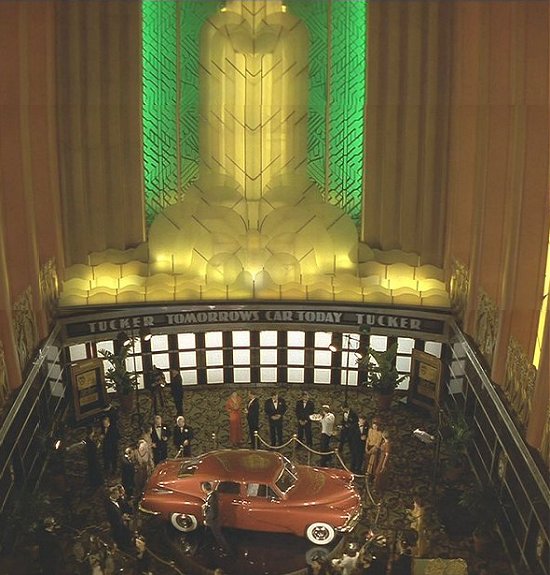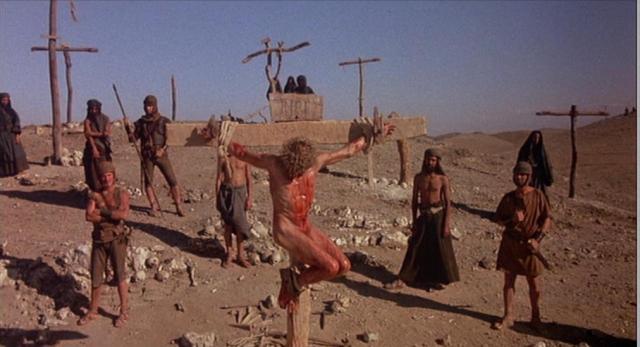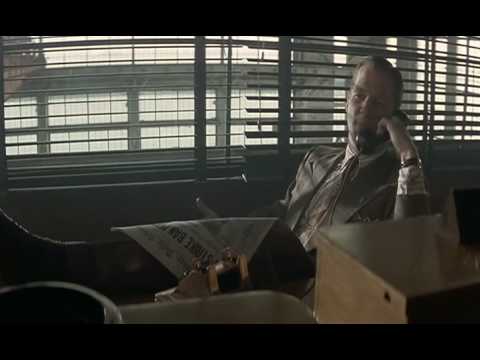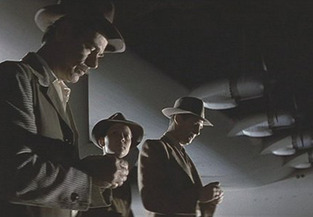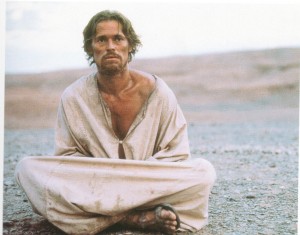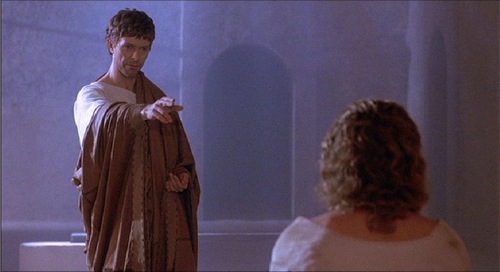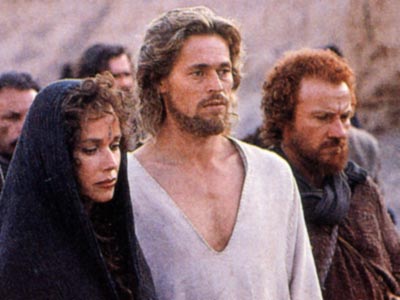This originally appeared in the August 19, 1988 issue of the Chicago Reader. –J.R.
TUCKER: THE MAN AND HIS DREAM
*** (A must-see)
Directed by Francis Ford Coppola
Written by Arnold Schulman and David Seidler
With Jeff Bridges, Joan Allen, Martin Landau, Frederic Forrest, Mako, and Dean Stockwell.
THE LAST TEMPTATION OF CHRIST
*** (A must-see)
Directed by Martin Scorsese
Written by Paul Schrader
With Willem Dafoe, Harvey Keitel, Barbara Hershey, Harry Dean Stanton, David Bowie, Verna Bloom, Randy Danson, and Andre Gregory.
While it might initially seem like a shotgun marriage to consider together movies as different in tone and subject as Tucker: The Man and His Dream and The Last Temptation of Christ, it is worth noting first of all that these films represent comparable watersheds in the careers of their respective directors. Even if we put aside that Francis Ford Coppola and Martin Scorsese are contemporaries (born in 1939 and 1942, respectively) with Italian and Catholic backgrounds, and that both became star directors during the same period — with Coppola’s The Godfather in 1972 and Scorsese’s Mean Streets in 1973 — we are still left with the fact that their latest features are both intensely personal projects, nurtured by their creators over many years and through a number of vicissitudes.
Scorsese’s interest in making The Last Temptation of Christ can be traced back to 1972, when Barbara Hershey gave him a copy of Nikos Kazantzakis’s novel, although he has stated that his desire to make a film about Jesus began during his early childhood, when he was simultaneously becoming involved with movies and with the Catholic Church. (He nearly made The Last Temptation in Israel about five years ago, with Aidan Quinn [of Reckless and Desperately Seeking Susan] cast as Jesus, but the budget fell through at the very last moment.)
Coppola, on the other hand, traces his fascination with car designer and manufacturer Preston Tucker back to the time when Coppola was eight and his father took him to a car show; his father was one of the original investors in Tucker’s company, so the connection went deeper than mere aesthetics. Coppola has been interested in making a movie about Tucker at least as far back as the 70s; after Apocalypse Now, he briefly worked with Leonard Bernstein in developing a musical about him, “a multi-image extravaganza.”
As a result of these virtually lifelong involvements — obsession in the case of Scorsese and Jesus, fascination in the case of Coppola and Tucker — the films qualify as the testaments of their respective directors, as well as their passionate if idiosyncratic self-portraits. To my mind both are flawed works, but each represents a major advance over its director’s more recent bread-and-butter work: Tucker is a solid improvement on Coppola’s The Cotton Club and Peggy Sue Got Married, and The Last Temptation is much more impressive than Scorsese’s After Hours and The Color of Money. Both films have been getting a lot of press about their subject matter and very little about their styles, although it must be conceded that their styles are as radically different as their subjects (and their respective social impacts, which are no less important). The reason for addressing these distinctions is that the differences between these films are as pertinent as their similarities: what each one lacks, the other has in spades.
Above all, Tucker has showmanship, and showmanship is in large measure its subject. The story of Preston Thomas Tucker — described by Collier’s magazine in 1949 as “a bewildering combination of P.T. Barnum, Huck Finn, Jimmy Walker, and Baron Munchhausen” — is basically the story of a particular version of the American Dream that took root in the postwar 40s. Part of it is epitomized by the Tucker Torpedo, a dream car that was based on aerodynamic principles and offered fuel injection, disc brakes, a single button to open and close all the doors, several novel safety features (including a pop-out windshield), and a relatively affordable price. But an equally important part of the dream (according to the film, at least) is the extended family that produced and promoted the car: Tucker’s own large family, which was an omnipresent and integral part of the enterprise, plus his business manager. Abe Karatz (Martin Landau), his grease monkey Eddie Dean (Frederic Forrest), his test driver Jimmy Sakuyama (Mako), and such figures as his housekeeper, his press agent, and the filmmaker who made promotional shorts about him and his car.
In short, the dream of Tucker, composed from a combination of fact and fancy, is about both a product and a style or mode of production. As many commentators have noted, this dream bears a distinct relationship to Coppola’s own ambitious and ill-fated Zoetrope Studio, which was designed to foster collective innovation and brainstorming as much as individual self-aggrandizement (at least in theory). Zoetrope, like the Torpedo, perished under a pile of debts and unsympathetic pressures from big-business competitors (Hollywood in Coppola’s case, Detroit in Tucker’s). Tucker’s talents seem to have been those of an entrepreneur and a showman rather than those of a lone thinker and a solitary inventor; similarly, at the same time Coppola’s stock as a director and auteur was suffering severe depreciation — mainly because of One From the Heart, The Outsiders, Rumble Fish, The Cotton Club, Peggy Sue Got Married, and Gardens of Stone — he was stamping his name in large letters over (mainly) much better films and film events by Abel Gance (Napoleon), Hans-Jürgen Syberberg (Hitler, a Film From Germany and Parsifal), Jean-Luc Godard (Passion), Wim Wenders (Hammett), Carroll Ballard (The Black Stallion), and many others, as producer and/or promoter.
(The same notion of an extended family was vividly conveyed in TV coverage of the Democratic Convention last month — not so much the separate families of Dukakis and Jackson, although these were certainly evident, as the intermingling of diverse factions within the party, despite the efforts of most TV commentators to play up the conflicts and differences. Tucker seems perfectly timed as a slice of populist uplift to accompany the Democratic campaign, juxtaposing the wide-eyed aspirations of the “little man” with the crushing obstacles of big business.)
Combining upbeat big-band music and handsome ‘Scope framing with the luscious period recreations of production designer Dean Tavoularis and cinematographer Vittorio Storaro (both charter members of the Coppola “family”), Coppola creates a heady enthusiasm not only for the idealism of the late 40s, but also for the remnants of that euphoria that survive in the present. The main stylistic models in evidence all come from the 40s: Citizen Kane (in the flashy transitions between scenes and in the promotional film about Tucker that opens the movie, a pastiche that functions much like the Kane newsreel); Capra’s Meet John Doe and It’s a Wonderful Life; and the films of Preston Sturges.
But there’s a significant difference between Tucker and these predecessors. Coppola’s protagonist is a character incapable of introspection and self-scrutiny, a triumph of pure image. Jeff Bridges, who plays the part well and likably, keeps virtually the same shit-eating grin plastered on his face throughout the movie, regardless of whether he is celebrating the completion of his first prototype car or smashing objects in a rage against the wall. The shallow smile is an emblem; Coppola views Tucker, his period, and his world exclusively in terms of advertising — the Norman Rockwellish view of America found in magazine ads and illustrations of the period. The cartoon villains of Tucker are like the comical Republicans recently evoked and derided in Atlanta — one-dimensional reductions of media images that lack dimension to begin with. The movie has a flat surface that allows Coppola a great deal of grace and fluidity in traversing his material (as happened to a lesser extent in the foreshortening of One From the Heart), but it can’t dig far enough into the dark corners of its dream to create a world as dense as those of his ostensible models.
What Tucker offers in terms of stylistic innovation combines the narrative thrust of The Godfather with the technologically contrived dream bubbles of One From the Heart; both the meat of the former and the froth of the latter are trimmed in the synthesis, but what remains in the giddy spatial effects is occasionally as exciting as anything Coppola has done, and it is directly expressive of the extended family idea as well. The grandest moment of all, fully worthy of Kane, is a spectacular transition between Tucker’s cozy and crowded kitchen in Ypsilanti, Michigan, and his empty 73-acre factory in Chicago, waiting to be filled. During a brainstorming session in the kitchen, Abe describes the factory that’s just been acquired; Tucker says, “It’s perfect!” He twirls his hat around his finger, and without a cut steps directly into the epic reaches of the plant — an exhilarating hop from dream to reality. Only slightly less effective is the stylized framing of certain phone conversations between Tucker and various members of his family; both ends of these conversations take place within the same theatrical space, which similarly suggests a utopian proximity between home and work.
In a wholly invented scene designed to push home Coppola’s message, Howard Hughes (nicely played by Dean Stockwell) points to his Spruce Goose and asks Tucker, “Who cares whether it flies or not? That’s not the point.” Later, after Tucker offers an eloquent self-defense (another ahistorical addition) at his trial for fraud — declaring, in tones worthy of a Capra hero, “If Benjamin Franklin were alive today, he’d be thrown in jail for flying a kite without a license” and virtually predicting the future importing of Japanese radios — he manages to be sanguine about the fact that only 50 Tucker cars ever made it off the assembly line. “What’s the difference, 50 or 50 million? That’s only machinery. It’s the idea that counts — and the dream.”
The simplicity of all this may finally not be enough, but at least it is genuine; and unlike the high-flown simplicities of One From the Heart and the cop-out rhetoric that mars the endings of The Rain People and Apocalypse Now, it isn’t condescending, either. The heavy-breathing portentousness of the earlier Coppola — which led to such self-regarding glibness as the use of Nino Rota’s ubiquitous Godfather waltz theme on the church organ during a communion scene in The Godfather Part II — has here given way to a relaxed vernacular and a relative modesty that permit Coppola to get through Tucker without ever tripping over himself. The scale of his own aspirations may be smaller now, but he plays it straight, without filigree or filibuster.
***
“You don’t make up for your sins in church,” says Charlie (Harvey Keitel) offscreen at the very beginning of Mean Streets; “you do it in the streets; you do it at home. The rest is bullshit, and you know it.” Here in a nutshell are the contradictions of Martin Scorsese’s cinema: an unrequited desire for absolution crossed with profanity, a tortured conflict between flesh and spirit, and a spiritual crisis that is so internalized that it never moves beyond self-scrutiny. (The first act performed by Charlie in Mean Streets is to get out of bed and look in a mirror.)
Far from being “nice,” Scorsese’s Catholicism has always had its unhealthy and even repellent side; but Scorsese goes immeasurably farther into both his obsessions and the possibilities and implications of his art than a nice-guy director like Coppola; niceness isn’t the point. (One could never accuse Scorsese of holding to the notion that George Orwell found in Graham Greene, that “there is something rather distingué in being damned”; Scorsese seems to know hell like the back of his hand, and he doesn’t find it amusing.) Coppola is content to stick with his little kernel of truth, heat it until it pops, and savor the fluffy corn for all it’s worth; Scorsese plunges into the unknown without a return address, riddled with guilt and conflict, and what emerges is both an authentic and an authentically upsetting struggle, illuminating yet perpetually unresolved.
If Scorsese is easy to misunderstand, so are virtually all the leading filmmakers of doubt — Dreyer, Rossellini, Godard, Rivette, Preminger, Cassavetes — for whom a shot is often a question rather than an answer, a hypothesis rather than fact. This is a kind of filmmaking that implies an intimate and serious dialogue with the audience, but a good many spectators — and not only members of the Coppola parish — would rather be preached to, simply and entertainingly.
The religious doubts of Scorsese, one should stress, are not doubts about religion, but, on the contrary, doubts that could only exist within a system of religious belief. Not that this makes the doubts any easier to swallow, even for nonbelievers. Writing about Roberto Rossellini — another devout but conflicted Catholic — in 1955, Jacques Rivette stated that “Catholicism is by vocation a scandalous religion; the fact that our body, like Christ, also plays its part in the divine mystery is something hardly to everyone’s taste, and in this creed that makes the presence of the flesh one of its dogmas, there is a concrete meaning, weighty, almost sensual, to flesh and matter that is highly repugnant to chaste spirits.”
For Scorsese, who discovered movies and Catholicism around the same time, film itself has both its sacred and profane sides — a notion that is clearly shared by the less talented but equally divided screenwriter and director Paul Schrader, who came from. a Dutch Calvinist background in which movies were strictly forbidden, and who worked on the scripts of Scorsese’s Taxi Driver, Raging Bull, and The Last Temptation of Christ. Left to his own devices, Schrader has often exploited religious conflicts to express a violent worldview that borders on the fascistic; Scorsese’s uses of this worldview in Taxi Driver and Raging Bull are full of problems and rife with contradictions, but they can never be read as unambiguous celebrations of fascist power to the degree that Schrader’s own films (such as Mishima) sometimes are. With and without Schrader, Scorsese has most often in the past used his religious conflicts to dramatize, objectify, and explore his secular subjects, not to exploit them.
In the case of The Last Temptation of Christ, in which Scorsese finally confronts these conflicts squarely and directly, they become the struggle of Jesus Himself between His own humanity and His divinity — between the constant temptation of evil and the acceptance of His martyrdom. This is the theme of Nikos Kazantzakis’s novel, which uses this struggle to radically reinterpret Jesus’s life (and which provoked its own share of controversy when it was first published in Greece three decades ago). In Kazantzakis’s version, Jesus is so alienated from His divine calling that He is first seen as a carpenter building crosses for the Romans to crucify Jews on. Only through the efforts of Judas is the establishment of Christianity made possible; he is a political activist who sets Jesus on the right path, and who ultimately betrays Him to the Romans only at Jesus’s insistence, as a strategy to ensure His martyrdom. And after Jesus is lured down from the cross by Satan (who is disguised as a guardian angel) to lead an ordinary human life with Mary Magdalene and, after her death, with Martha, it is Judas again who persuades Jesus to return to the cross and accept His final suffering “like a man.”
While I haven’t read Kazantzakis’s novel straight through, I’ve spent enough time with it to confirm that Scorsese’s film is a reasonably close and faithful adaptation, at least in terms of plot. Even the use of contemporary American accents and plain (as opposed to exalted) dialogue can be defended as a sensible substitute for Kazantzakis’s use of the popular, “demotic” language of the Greek peasantry rather than the “puristic” language of Athenian intellectuals (as described by his English translator P.A. Bien); the use of electric guitars and some hints of rock percussion in Peter Gabriel’s score (along with traditional North African and Middle Eastern music) can be justified on similar grounds. Kazantzakis, one should note, successively embraced Bergson, Nietzsche, Buddha, Lenin, and Odysseus as his spiritual guides before he returned to Christ, whom he first encountered as a teenager; he didn’t write The Last Temptation of Christ until his late 60s.
Scorsese has argued that the view of Christ he has taken from Kazantzakis is not so much a reflection of his own belief as a revealing postulate: “I don’t say the concept . . . is the truth, but it is a fascinating idea. In Kazantzakis’s depiction, Jesus wrestles with the human side of His nature as He comes to terms with the God within Him. Because of His dual nature, human and divine, every moment of His life is a conflict and a victory.” The film, like the novel, seeks to stage the same conflict and victory in the spectator/reader, and the figure of Jesus becomes, in effect, the theater of that encounter. The challenge of the story, in short, isn’t merely that Jesus is tempted by human frailty, but that the audience is asked to identify with this same conflict, masochistically as well as narcissistically.
It is a conflict that leaves little room for any developed sense of community, and just as little space for love as something more than an abstract sentiment. Everyone who sees The Last Temptation will bring his or her own sense of Jesus to match against Scorsese’s version. My own sense of Jesus, for example, is that He loved lepers more than Ronald Reagan loves AIDS patients, but this is not the impression that Willem Dafoe’s Jesus leaves us with. Like all the other actors in the film, Dafoe is admirable and impressive (although I for one wish he were a little less well-groomed), but the film keeps him so tightly focused on Jesus’s inner struggles that the evidences of humanity around Him seem to figure mainly as props. As in Scorsese’s other films, the notion of the extended family, so central to the Gospels (as well as to Tucker), is simply beyond the reach of the protagonist, who is caught mainly between various forms of narcissism and self-loathing. (Indeed, one reason why The King of Comedy may be Scorsese’s masterpiece to date is that he found the perfect medium for this stalemate in TV — a combined Narcissus pool and family surrogate for nearly all of the film’s major characters.)
Although Scorsese’s own family is inscribed in much of his work — both his parents, for instance, play significant if elliptical roles in The King of Comedy — his heroes are isolated in ways that Coppola’s heroes seldom are (apart from the striking exceptions of Apocalypse Now and The Conversation): in place of the extended and/or surrogate families in The Rain People, the two Godfather films, Rumble Fish, and Tucker, we get characters who are profoundly estranged from their real or surrogate families throughout Mean Streets, New York, New York, Taxi Driver, Raging Bull, The King of Comedy, and The Last Temptation. The dream sequence in the latter, which is what causes so much grief to fundamentalists — a dream of normality, domesticity, and procreation that offends only because Jesus is the dreamer and protagonist — corresponds precisely to what is unattainable in Scorsese’s world, and omnipresent in Coppola’s. Women may be the ultimate status symbols in Scorsese’s films, but the principal passion in these films exists between men, whether this passion is expressed through love or brutality. (In The Last Temptation, it is basically the love that passes between Jesus and Judas, and Harvey Keitel as the latter has never been better in his expression of this tenderness.)
This leads to a curious difference between Satan (disguised, remember, as a guardian angel) in the novel and Satan in the film. In the novel, the angel is male; in the film, she is a beautiful little girl with an English accent. I can understand the reason for the English accent, which Scorsese assigns to all the Romans as well (including David Bowie as an effectively underplayed Pontius Pilate); apparently it is meant to link these characters to a more recent example of empire. But Scorsese’s use of females throughout the film to signify only maternity and temptation (of the male) makes me wonder if women of all denominations should be objecting to this film rather than fundamentalists of both sexes. (Admittedly, though, the roles of women in Tucker are even more restricted — in this case, to domesticity and decor.)
Previously, the hallmark of Scorsese’s style has been male hysteria, a special province that is shared (at least with Scorsese’s degree of intensity) only by a few other filmmakers — Jerry Lewis, Marco Ferreri, and — more intermittently — John Cassavetes and Elaine May. In The Last Temptation, this emotional register is present only fitfully, in certain moments of violence and in a couple of panicky subjective pans that convey Jesus’s sense that God is dogging His heels as He moves along a riverbank. On the whole, Scorsese’s stylistic strategies here add up to a series of negative decisions — a deliberate move to curtail the range of his expressive arsenal (in terms of color, framing, editing, and camera movement) in all but a few key moments, in order to concentrate more on theological questions. The narrative fluency of a film like Tucker is miles away from the broken rhythms of The Last Temptation, which proceeds mainly through fits and starts until Jesus arrives at the cross and His last temptation, when the action finally becomes compressed and powerful right up through the end.
Still, The Last Temptation is in no respect a timid or cautious film. In contrast to the easy-to-take Jesus of Cecil B. De Mille and Nicholas Ray’s separate versions of King of Kings (in 1927 and 1961, respectively), Scorsese’s life of Jesus is courageous enough to risk ridicule at every turn, and just as his doubts are exclusively those of a believer, his film’s address is essentially to believers and to those already steeped in the story of Jesus. (Others, like myself, may have to go back to the Gospels to clarify such incidents as Peter cutting off Malchus’s ear and Jesus replacing it.)
At the same time, it has to be admitted that a director’s own degree of religious faith has never been a guarantee of acceptability for other believers. Carl Dreyer, we now know, was not particularly religious, but it is conceivable that his depictions of religious faith in The Passion of Joan of Arc and Ordet are the greatest that we have on film, for believers and nonbelievers alike. (Whether his own projected but unrealized life of Jesus, conceived historically and polemically as a statement against anti-Semitism, would have met with strong objections is impossible to say.) By contrast, few Hollywood directors were more devout than Leo McCarey, but in his My Son John (1952), made during the height of the McCarthy witch-hunts, the authority of the Catholic Church, as represented by a comic local priest, plays a weak second fiddle to the patriarchal authority of the FBI.
Part of the difficulty in assessing The Last Temptation within the present climate is that the rash of fundamentalist protests against an idea associated with the film — it’s hard to call it a protest against the film itself if most of the protesters haven’t seen it — discourages close analysis by allowing certain misconceptions about the film, and about filmmaking in general, to hog the spotlight. The ludicrous widespread claims that MCA chairman Lew Wasserman is the “author” of the film — which is rather like calling Bennett Cerf of Random House the author of James Joyce’s Ulysses — is a chilling commentary on what Reagan capitalism has done to contemporary views of art and artists, a confusion of authorship with ownership that has already made personal Hollywood projects such as The Last Temptation almost impossible to conceive (and a project such as Tucker unthinkable without the sponsorship and “practical advice” of executive producer George Lucas). This focus on Wasserman has in turn occasioned an onslaught of anti-Semitic invective, from California to Italy (where director Franco Zeffirelli declared on national public radio that the unseen film was the product of “that Jewish scum from Los Angeles, which is always spoiling for a chance to attack the Christian world”).
The equally absurd claim that the film, the least commercially conceived project in Scorsese’s career, was made chiefly in order to turn a profit — presumably in contrast to such “pure” examples of religious exploitation as The Exorcist — is further complicated by the fact that the protest against the film is itself being used as a profit-making ploy by some fundamentalist leaders, at the same time that it is visibly helping (rather than hurting) the film’s box office.
The film’s depiction of Jesus’s wavering and temptation, which remains at the center of the controversy, is handled mundanely rather than salaciously by contemporary standards, but the fact that the film asks us to consider it at all still constitutes a challenge. By implying that Christianity is a battle that must be fought continually rather than a serene and unshakable given, it brings the question of faith alive again in a way that few religious films have attempted. On the other hand, by virtually restricting the world and humanity itself to a group of bit players and mere spectators to this conflict, the film can function politically (if at all) only within the church; from the vantage point of the world outside, it comes dangerously close to solipsism. The agony of the flesh is never far away, but because this agony is chiefly that of Jesus rather than the agony of mankind, the film often registers as convoluted inner turmoil rather than as social confrontation.
The interesting thing about both Tucker and The Last Temptation is that they place their emphasis not on worldly achievement but on the visions that rule the minds of two individuals. Much as Coppola’s Tucker can declare, “It’s the idea that counts — and the dream,” Scorsese’s (and Kazantzakis’s) Jesus can end His life on the cross by declaring, “It is accomplished,” referring not so much to the acceptance of His martyrdom as to the acceptance of the idea of His martyrdom, which Judas finally helps Him to put into place. Yet while Coppola can only conceive of Tucker’s vision through collective effort, Scorsese’s conception of Jesus’s vision rests on the belief that He basically lives and dies on the cross alone, and that His struggle — like that of the spectator — essentially remains a solitary one. After Jesus smiles and closes His eyes in His triumphant pain, a spray of psychedelic colors crosses the empty screen, followed by white. In this, the only moment of euphoria provided in the film (but in Scorsese’s terms, a moment that has been fully earned), the spectacle becomes a wholly private one for each spectator, not a communal experience to be shared.

